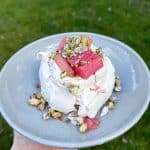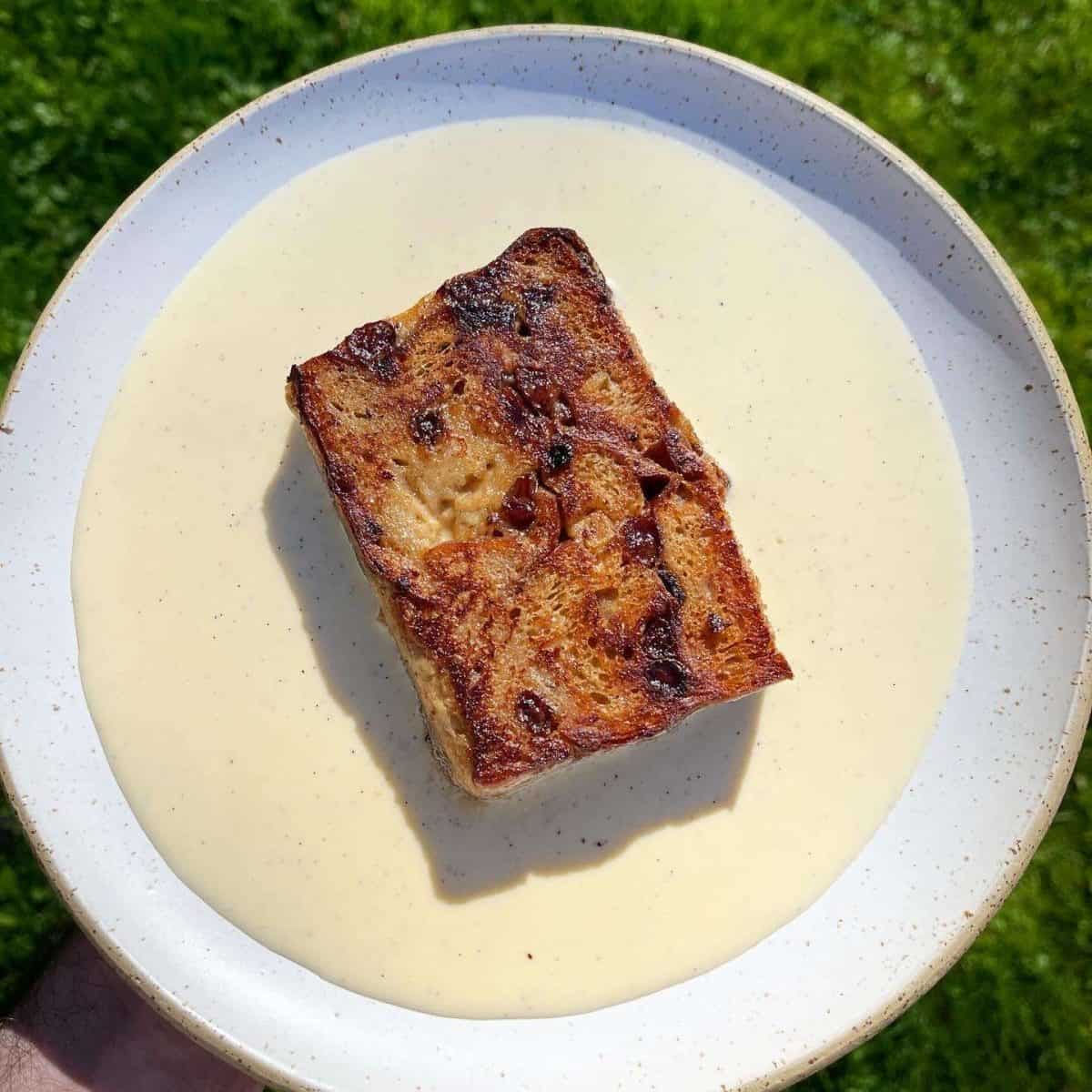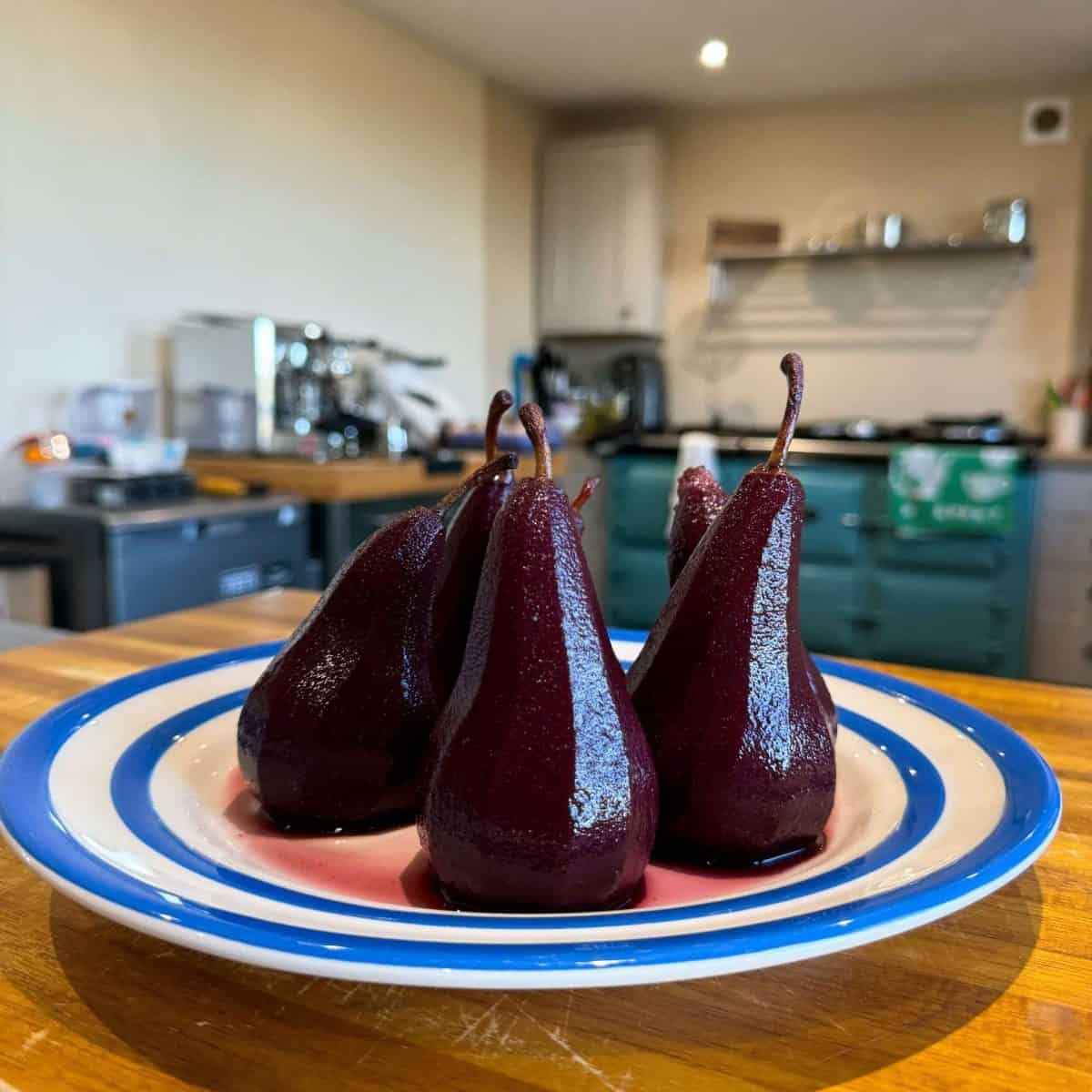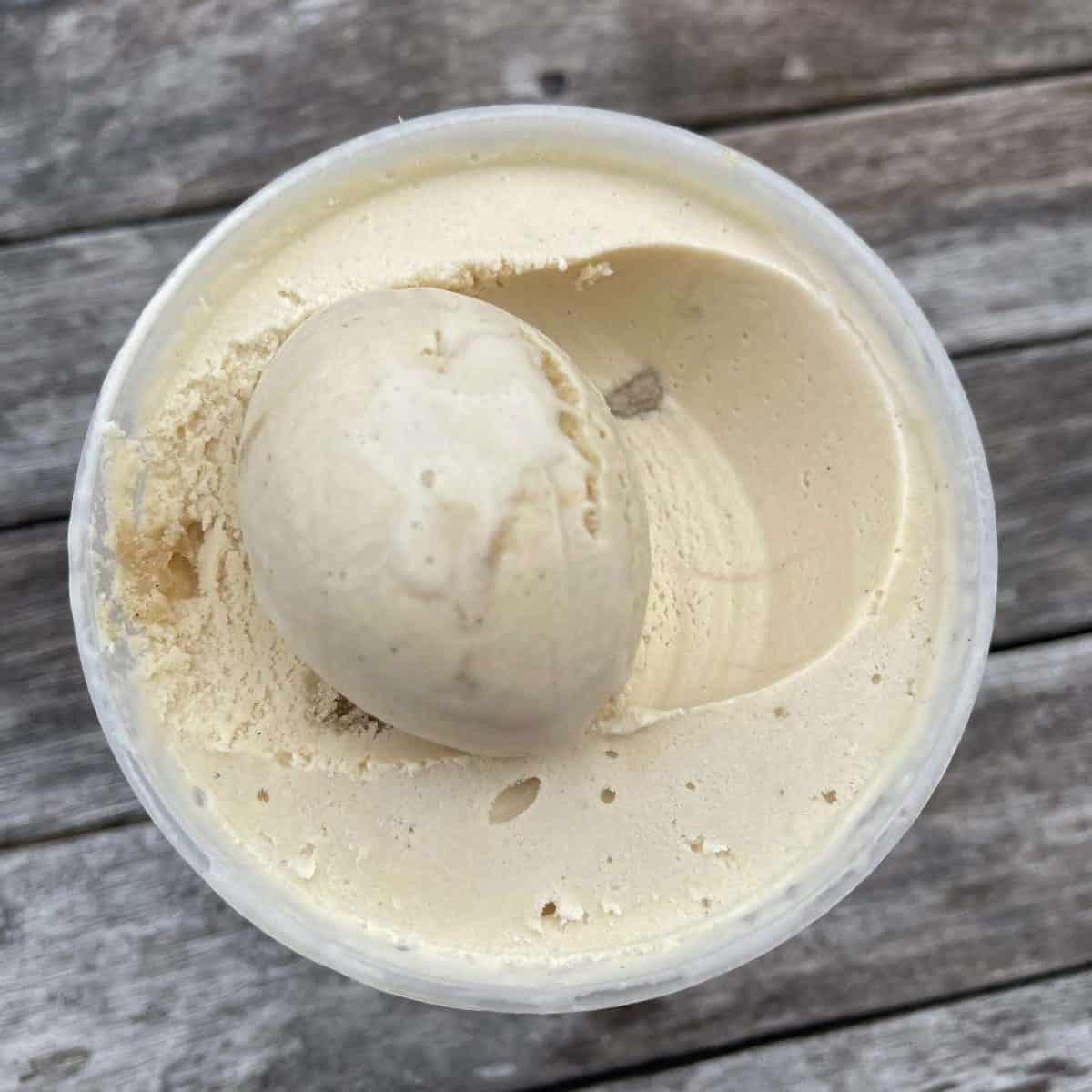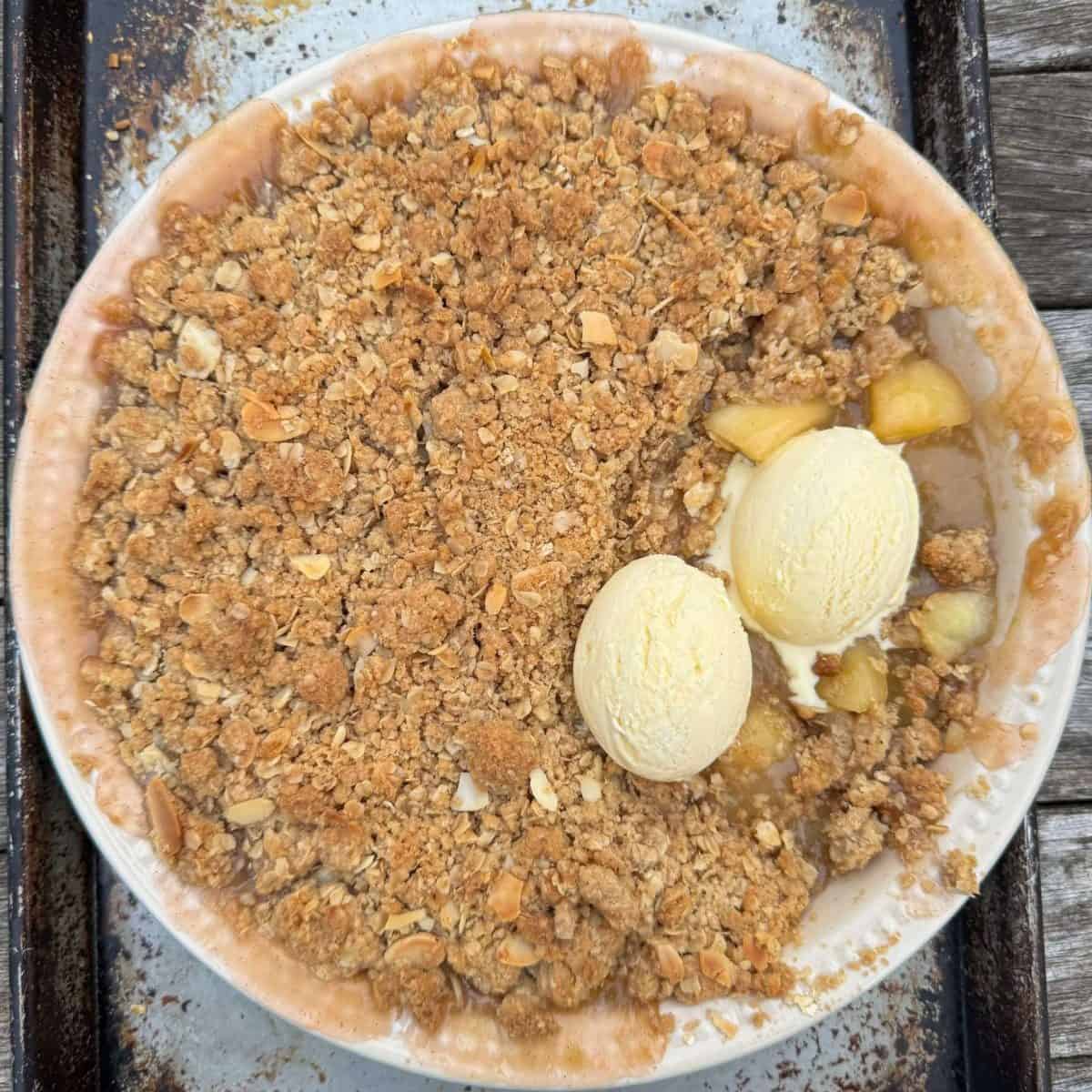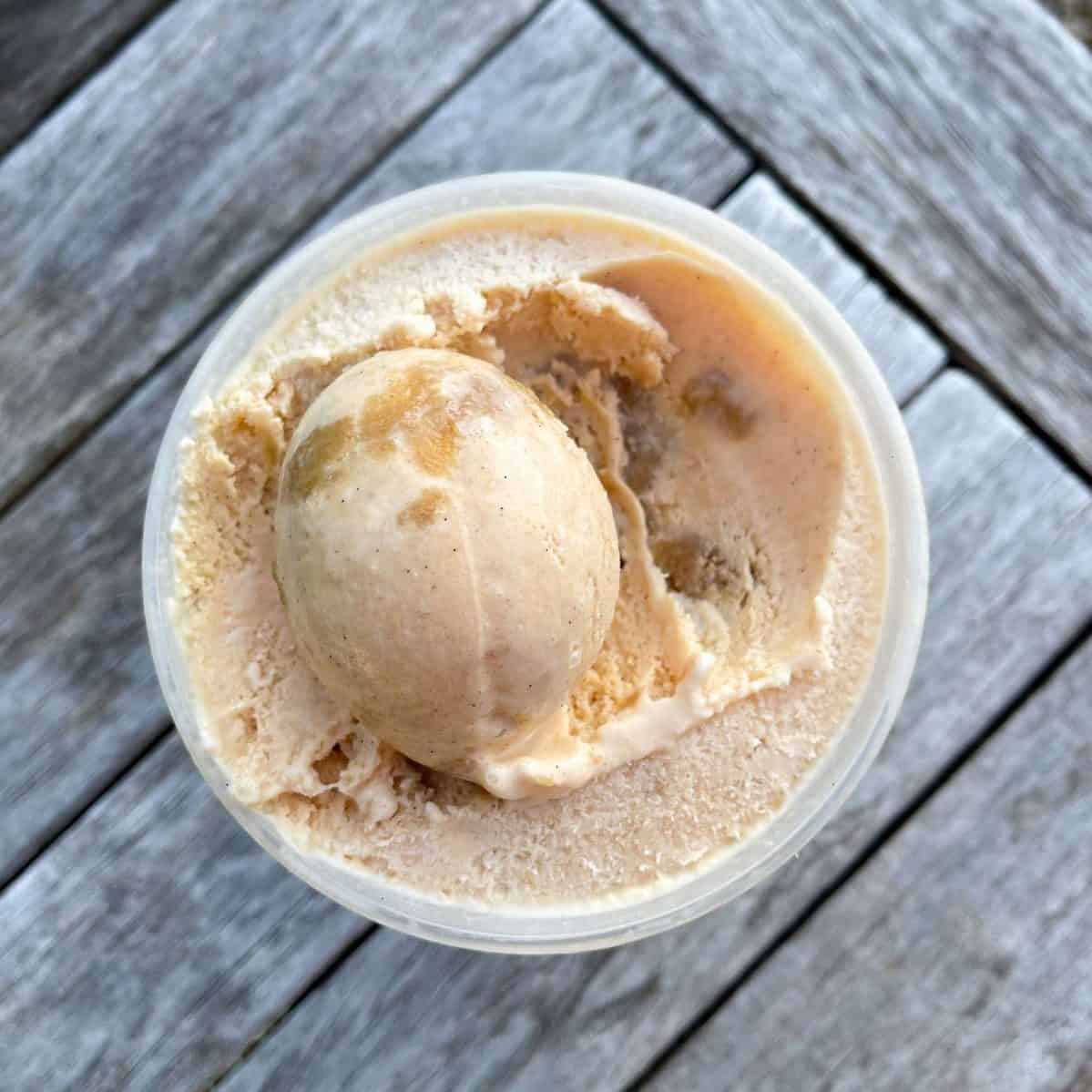Rhubarb & Custard Pavlovas With Crystallised Pistachios
We’re making marshmallowy mini pavlovas & serving them with vanilla pastry cream, roasted rhubarb, vanilla whipped cream & crunchy crystallised pistachios.
This post contains affiliate links.
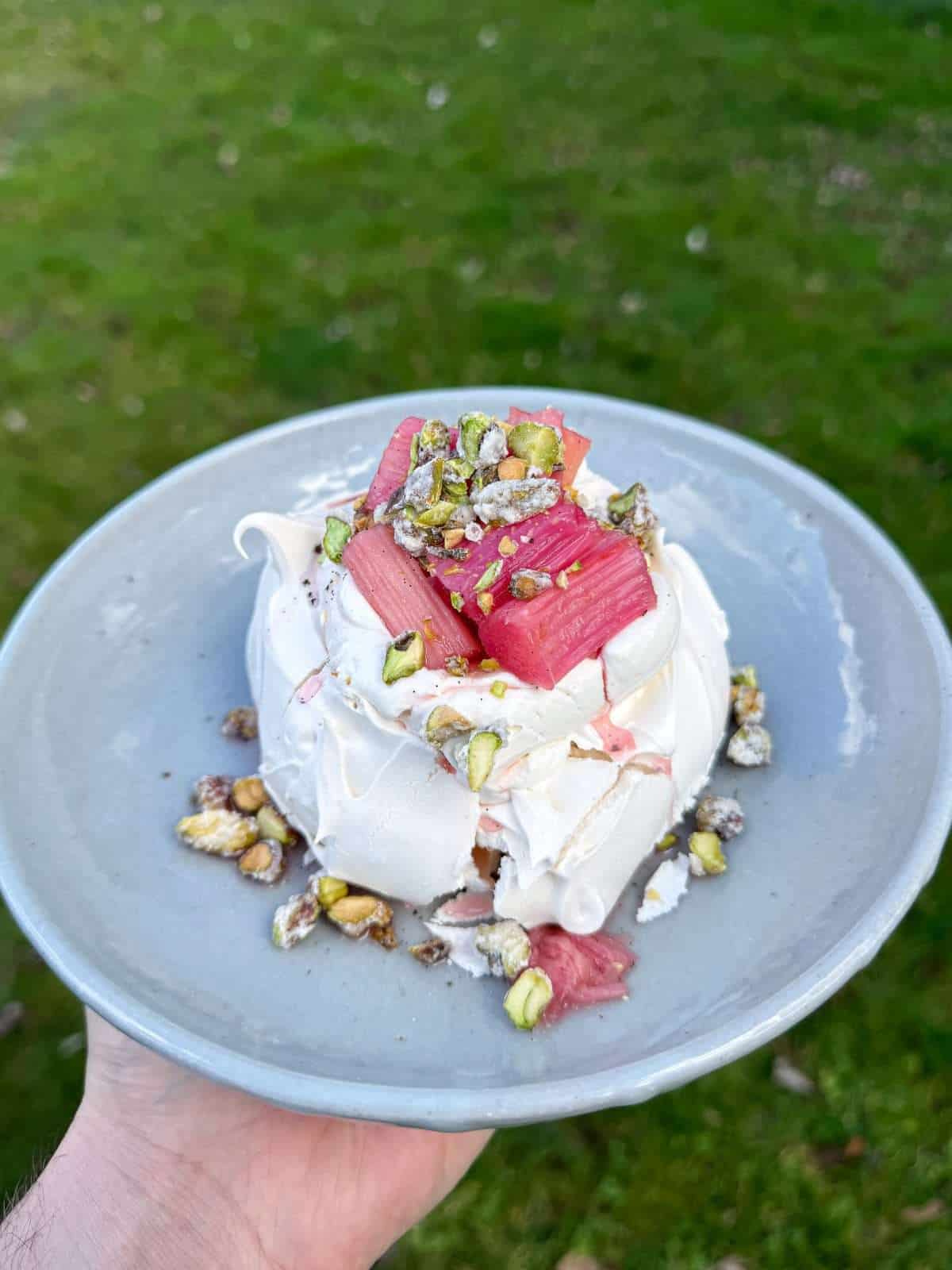
This pavlova recipes is perfect for when you’ve got some old egg whites that need using up. Plus, they’re incredibly delicious & take advantage of seasonal forced rhubarb and the classic flavour pairing that is rhubarb & custard!
To top our pavlovas, we’re going with some seasonal rhubarb which we’re going to be roasting until perfectly tender, plenty of velvety vanilla pastry cream, a good dollop of vanilla whipped cream and a sprinkle of crunchy crystallised pistachios. It’s the perfect balance of texture, sweetness & flavour.
I’ve done quite a lot of testing recently, to develop my ideal batch of individual pavlovas that are bright white, crisp on the outside & fluffy and marshmallowy in the middle. They’re super easy to make & are a great alternative to a classic, large pavlova. Plus, the seasonal toppings make it the perfect dessert to serve whilst the sun is shining!
If you’re looking for more pudding recipes to try then take a look at our ever growing collection of dessert recipes! There’s something for everyone here, from classic crumbles, sticky toffee pudding & treacle tart, to tiramisu & a whole load of homemade ice creams.
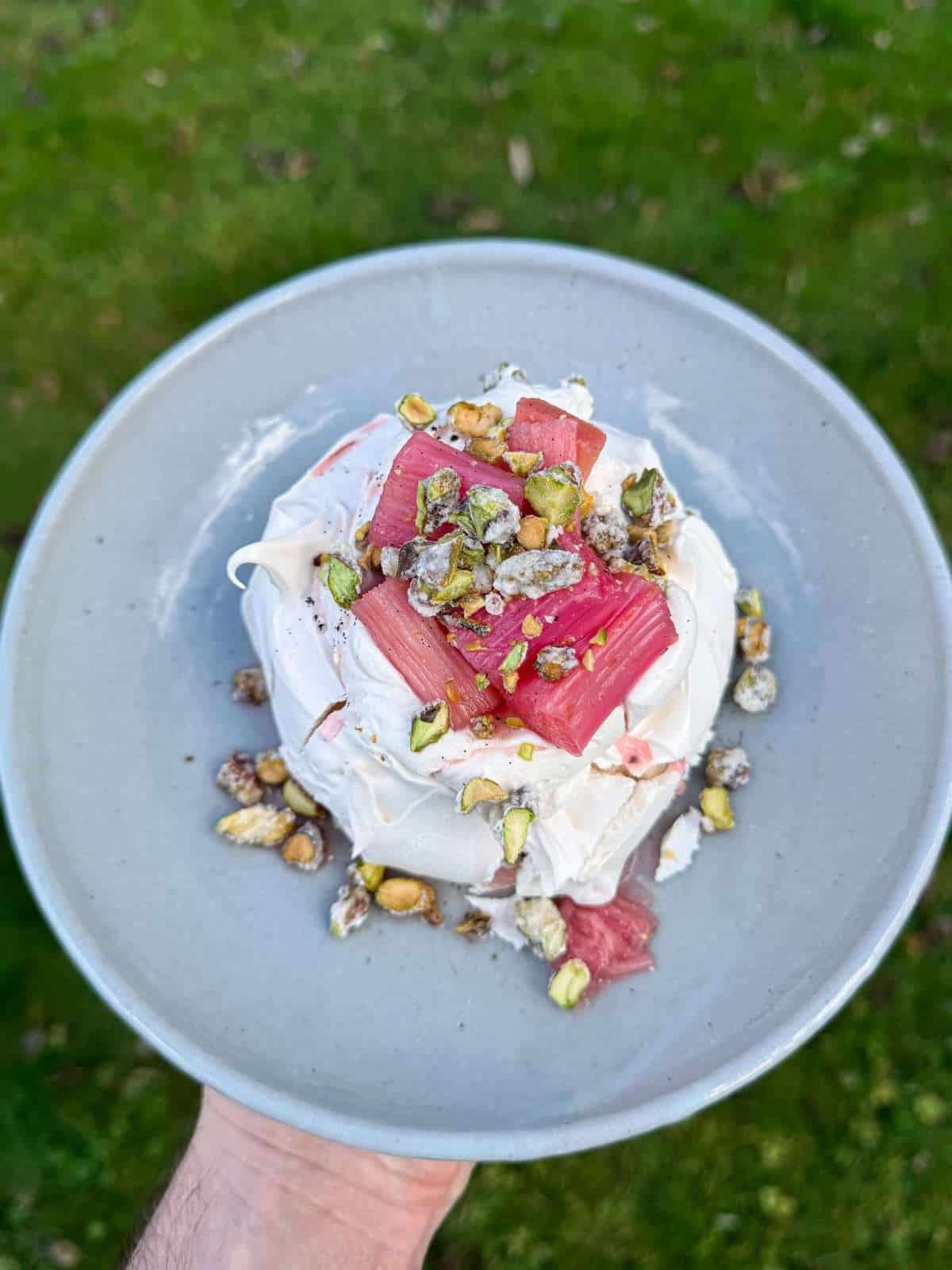

How To Make Individual Pavlovas
I reckon there’s something a bit more refined with a individual pavlovas! I’m a huge fan of this style of meringue as you get a higher ratio of filling to pavlova, plus they’re easier to serve & look fantastic. Here’s how to make them;
It’s important to make sure that your mixing bowl is clean & dry before making your meringue, otherwise it won’t whisk up properly! You’ll also need to line a large baking tray with baking parchment & preheat an oven to 160°c/320°f. I like to draw five 10 cm circles onto the parchment to use as a guide when shaping the pavlovas.
- Whisk Whites To Soft Peaks
First, we add room temperature egg whites into the bowl of a stand then whisk to soft peaks on a medium speed. This will take 2-3 minutes. - Add In Sugar
Next, we turn the mixer speed down slightly then add in caster sugar a tablespoon at a time, making sure to let each addition incorporate fully before adding in more. I find that adding a spoonful of sugar in every 20 seconds or so is best. - Whisk To Stiff Peaks
Once all the sugar has been added, we turn the mixer back up to medium then continue whisking for 15-20 minutes, until the meringue has reached stiff peaks and is thick & glossy. To check if the meringue is ready, rub it between your thumb & index finger. If it feels smooth, it’s ready but if it feels gritty then it needs more whisking. - Add In Cornflour, Vinegar & Vanilla
Next, we add cornflour, vinegar & vanilla to the meringue then whisk for another minute or so (on medium), until combined. - Shape Into Pavlovas
To shape the pavlovas, I find that it’s best to pipe large domes of meringue onto the tray (using the circles from earlier as a guide) then use a palette knife or spoon to shape into pavlovas that are roughly 5cm tall, with a small crater on top to hold the filling! - Bake
Once shaped, we place the tray of pavlovas into the preheated oven, immediately turn down to 110°c/230°f then bake for an hour or until the meringue is dry to the touch & comes off the baking paper when lifted up really gently. - Leave To Cool
As soon as the pavlovas are baked, we turn the oven off then let them cool completely whilst still inside the oven. This will take at least 4 hours but I find that leaving them overnight is best.
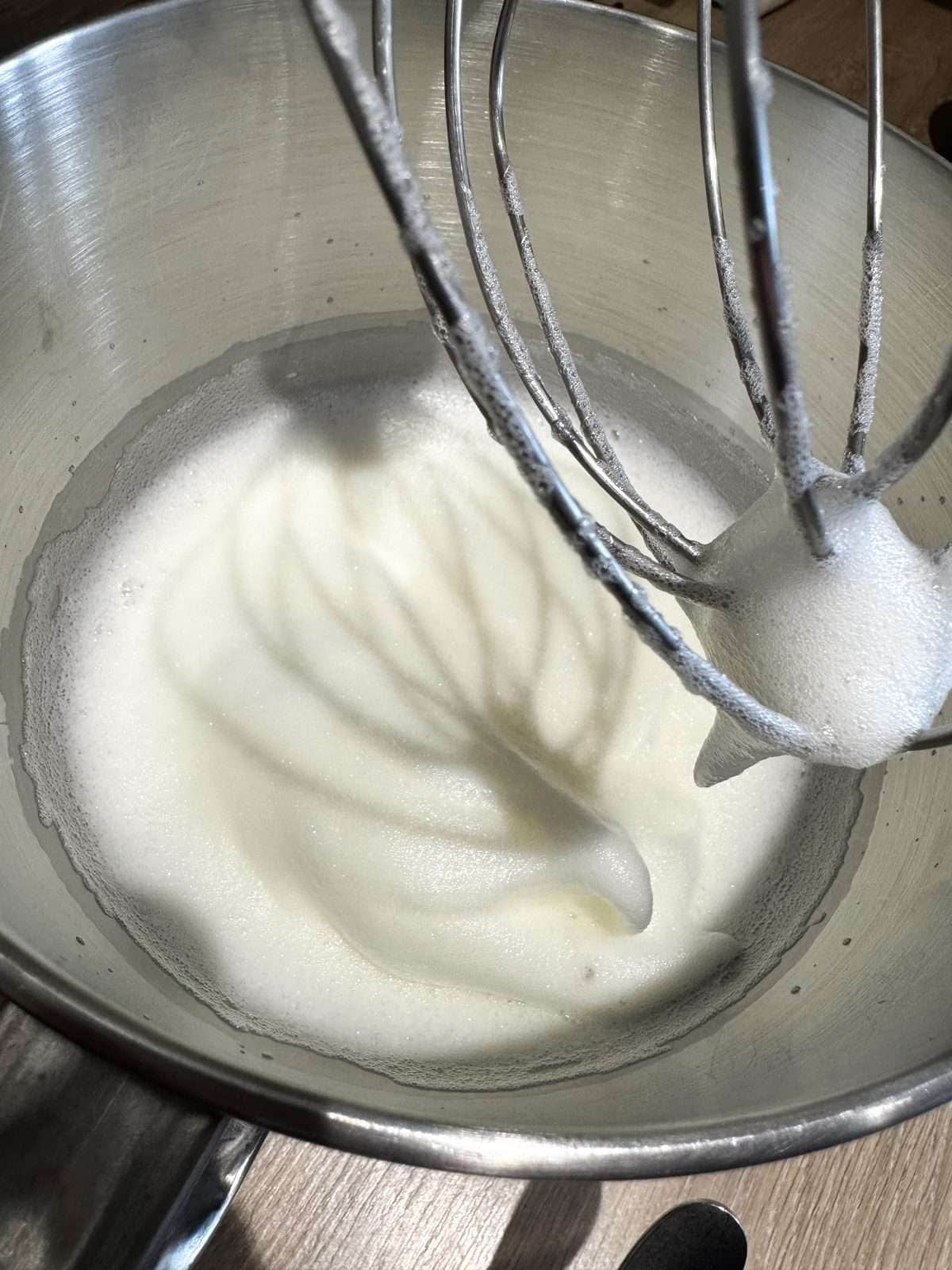
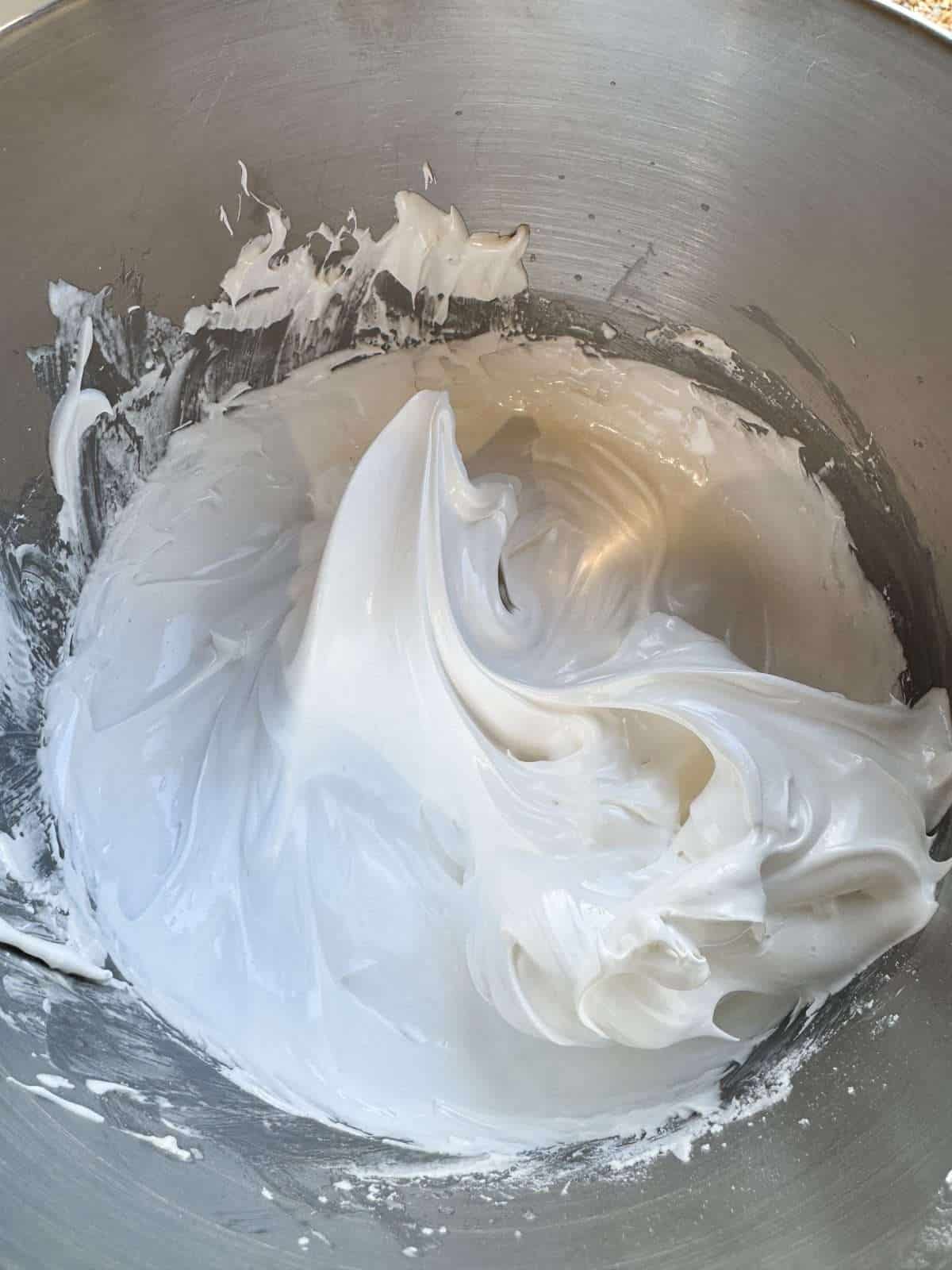
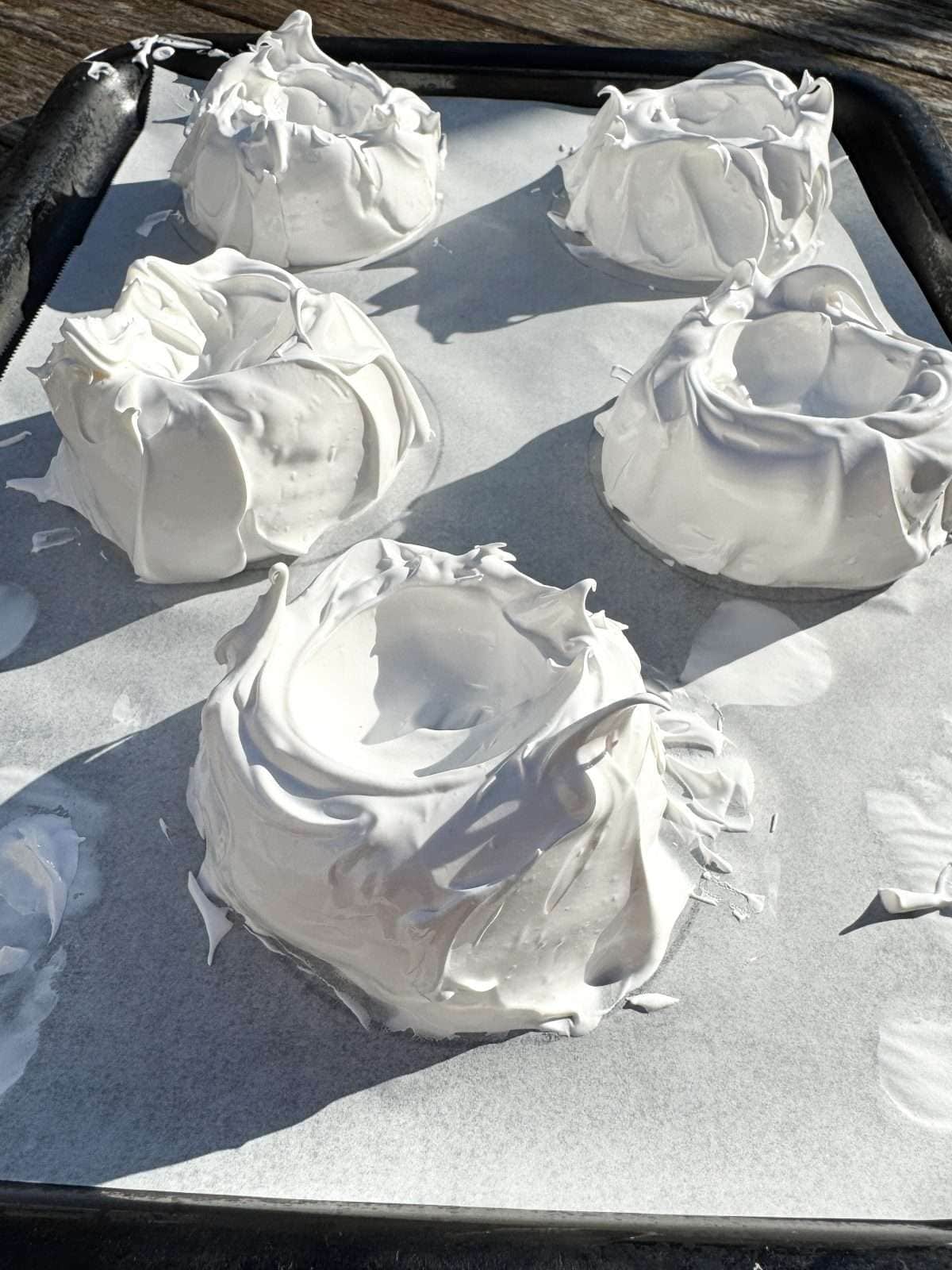
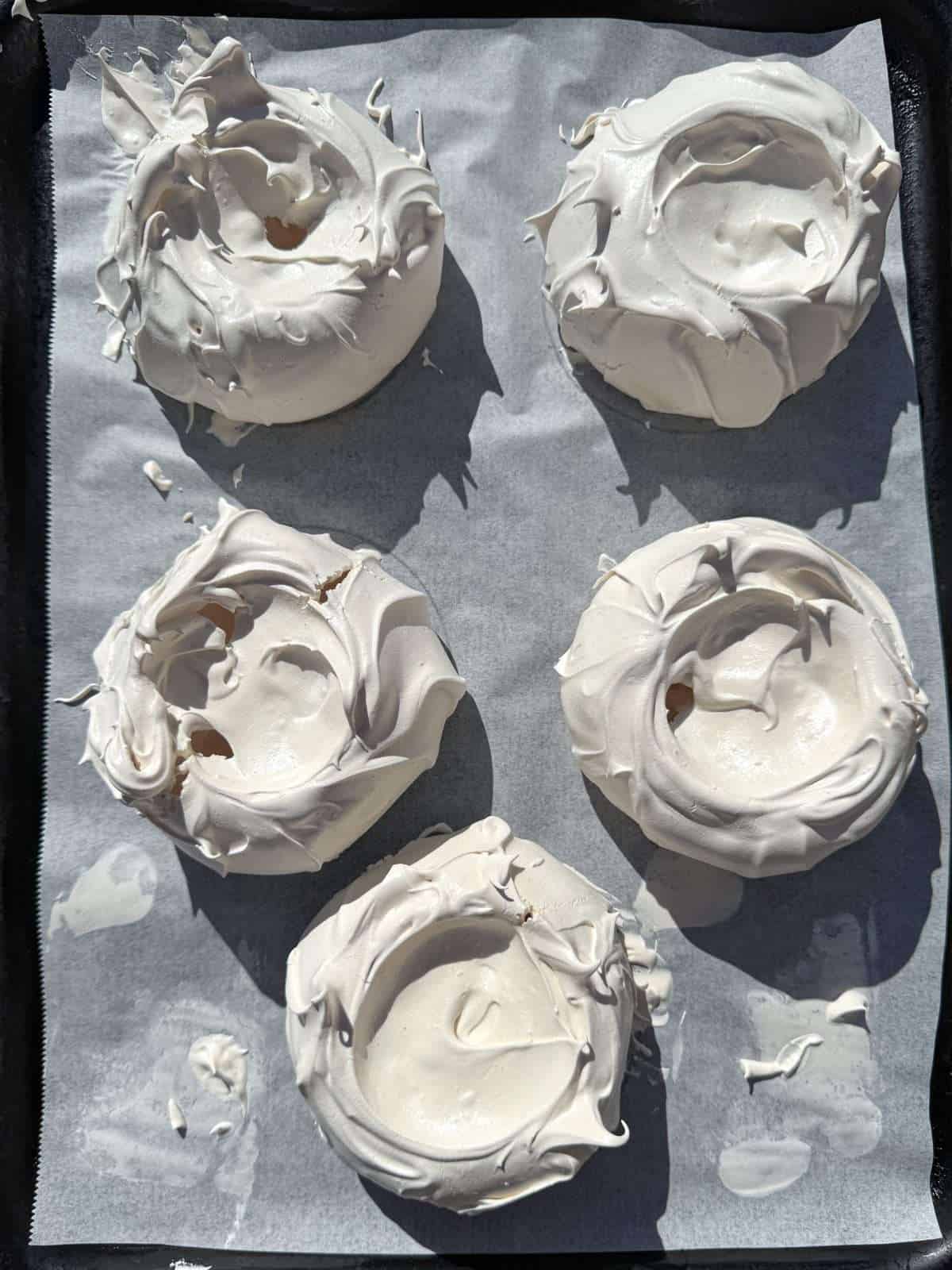
Pavlova Toppings
These pavlovas are inspired by the classic flavour combination that is rhubarb & custard! However, if you’re not a fan of rhubarb, they would be equally delicious with strawberries, raspberries or blueberries instead.
Vanilla Pastry Cream
Pastry cream is a type of custard that’s thickened with cornflour & enriched with butter, which gives it a pipeable consistency & rich flavour. This is made like most other egg custards, where we warm milk, sugar & vanilla on the stove then add in egg yolks & cornflour then cook out to thicken. Where it differs, is that we whisk butter into the custard at the end.
There’s a couple of key things to do here, to ensure that you get the best custard possible! First, the egg yolks must be tempered before being added into the warm milk, to prevent them curdling. To do this, we simply whisk some of the milk into the yolks off the heat before adding them back in. Then secondly, the custard must be cooked until it’s just starting to boil, so that the cornflour thickens it properly.
Roasted Rhubarb
Roasting is a super simple way to perfectly cook rhubarb & it takes very little effort & time! It’s best to cook rhubarb until it’s tender but still holds its’ shape and if you want vibrant pink rhubarb, you’ll need to use forced.
To make our roasted rhubarb, we cut the stalks into 1 inch pieces, add into a heatproof dish with sugar, vanilla & fresh orange juice, cover with foil then roast at 180°c/356°f for 25-30 minutes, until the pieces are tender but haven’t started to break down. Then to make the rhubarb turn a vibrant pink colour, we chill the fruit & syrup together overnight before serving.
Vanilla Whipped Cream
We’re topping our pavlovas with some double cream that’s flavoured with vanilla & whipped to very soft peaks. There’s no need to sweeten the whipped cream, as the pavlovas, custard & fruit are already quite sweet! For the best flavour, I’d recommend using a really good vanilla paste.
Crystallised Pistachios
Crystallised pistachios have this crunchy, frosty coating & are the perfect topping for our rhubarb & custard pavlovas! If you’re not a pistachio fan, pretty much any type of nut will work instead.
To make crystallised pistachios, first we need to roast the nuts at 180°c/356°f, for 4-5 minutes until they’re toasted & fragrant. Next, we add sugar & water into a small frying pan, cook over a medium heat until the sugar has dissolved then stir in the toasted nuts. Now, we keep cooking, stirring frequently until the sugar has crystallised around the nuts. Then we transfer the pistachios to a lined tray, let them cool completely then roughly chop before serving.

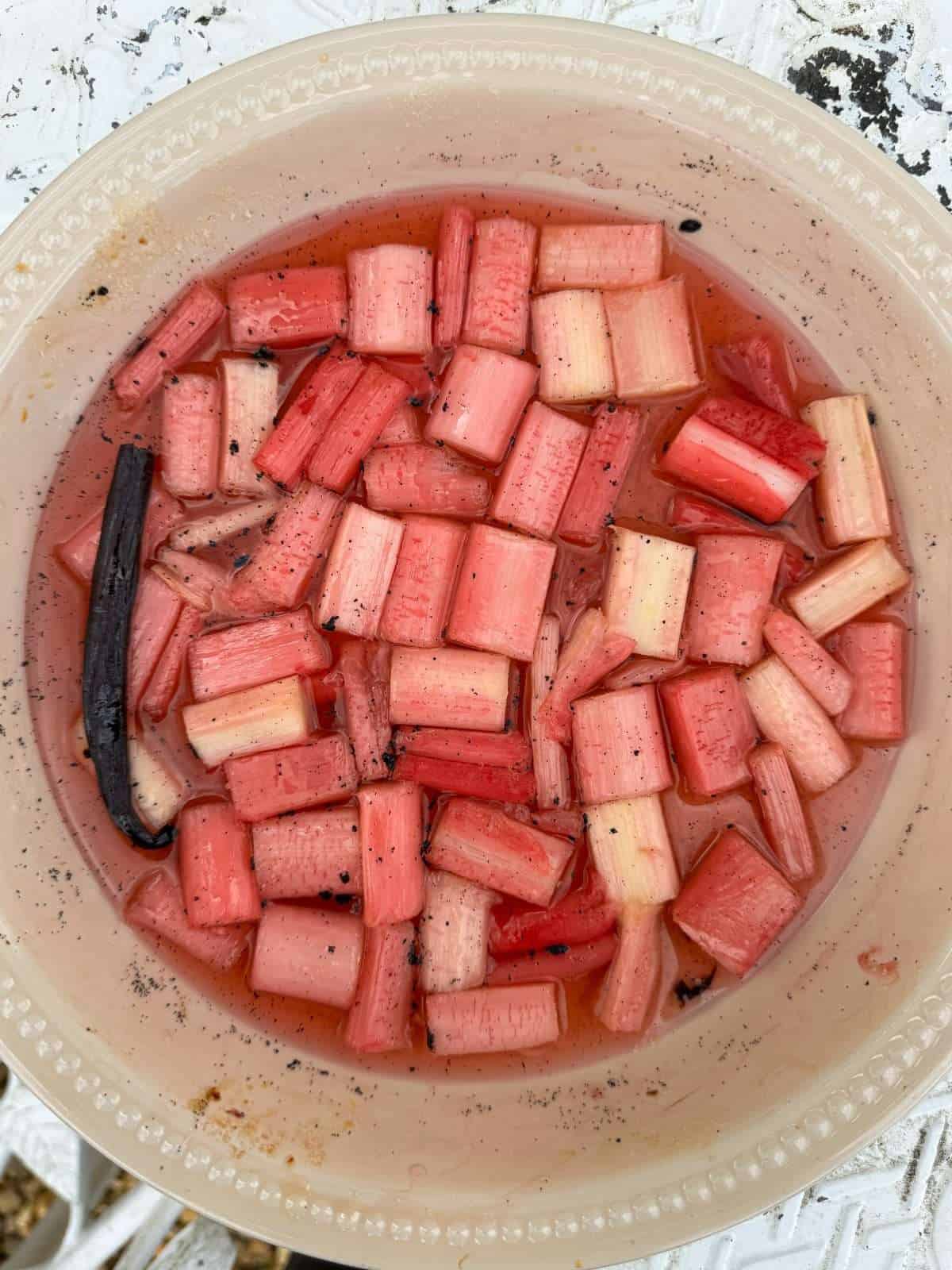
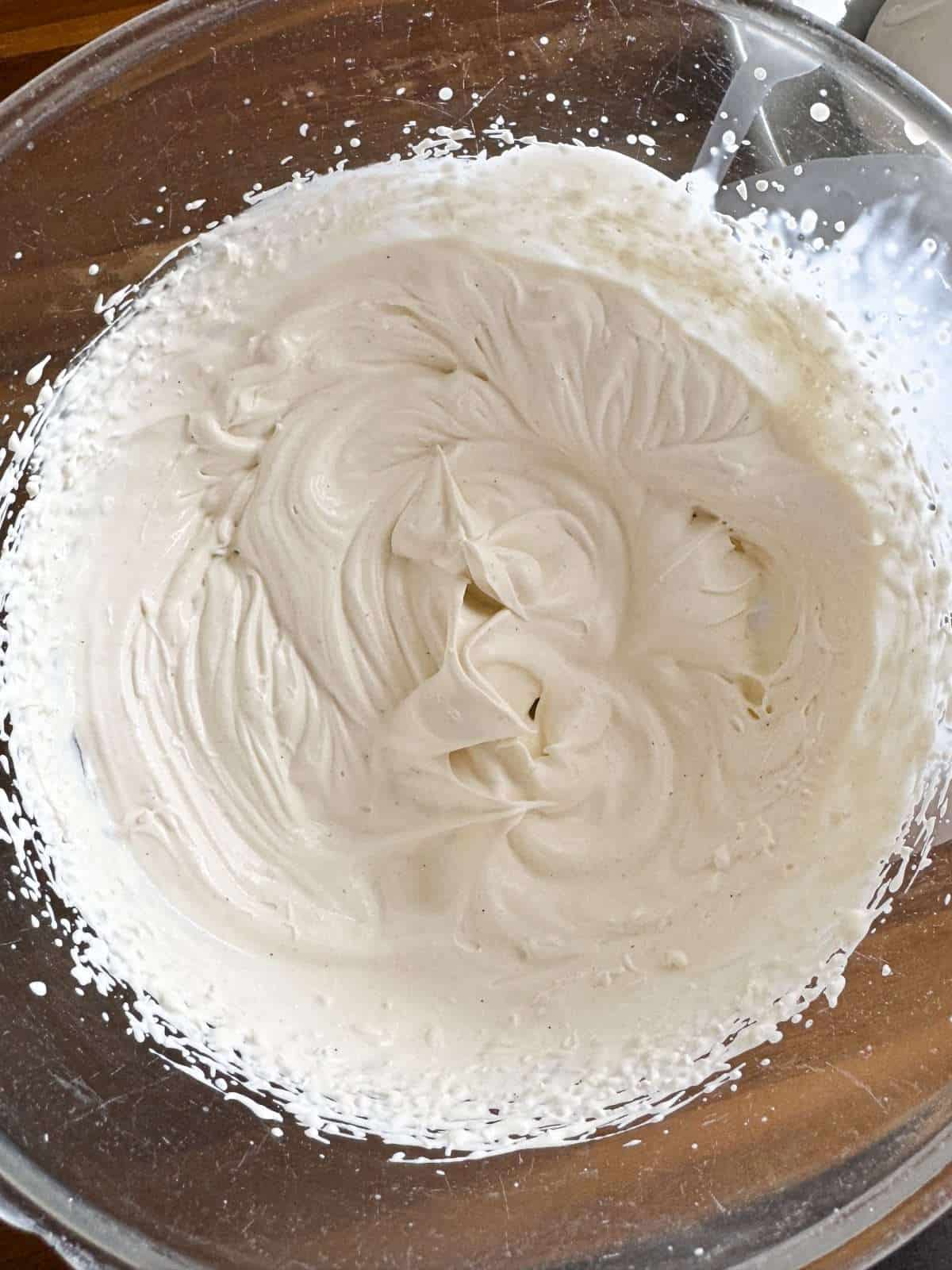
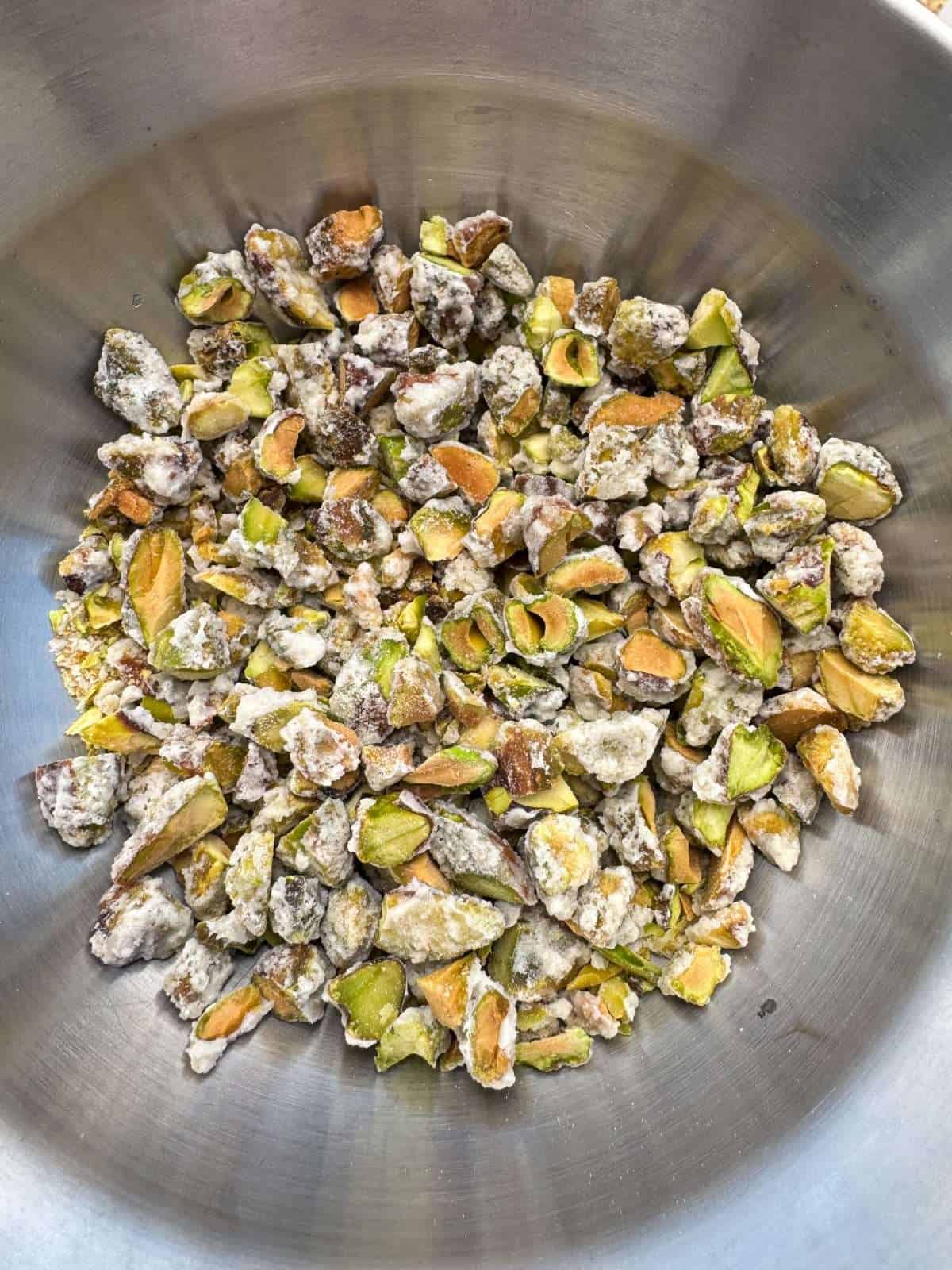
How To Assemble Rhubarb & Custard Pavlovas
The great thing about this dish is that it comes together last minute & is all about the prep! Once you’ve got all of the components ready, it’s just a matter of plating up…
- Crack Top
First, we give the top of each pavlova a firm tap with the back of a spoon, to break the meringue in the middle of the crater. This makes more room for toppings! - Pipe In Custard
Now, we pipe a generous amount of vanilla pastry cream inside the pavlova, stopping when we get to the bottom of the crater. - Top With Whipped Cream & Rhubarb
Next, we top the custard with a big dollop of whipped cream & plenty of the roasted rhubarb and syrup. If you make a small crater in the cream with the back of the cream, the rhubarb will sit nicely on top. - Sprinkle Over Pistachios
To finish, we sprinkle each pavlova with a good amount of the crystallised pistachios.
Tips & Tricks
- Make sure to fully dissolve the sugar in the meringue before using, as this will give the pavlovas the best texture & will prevent them weeping.
- Let your pavlovas cool in the turned off oven, to stop them cracking.
- For vibrant pink roasted rhubarb, use forced rhubarb!
- Use some really good vanilla in the custard & rhubarb, for the best flavour.
- Whip your cream last minute, so that it holds its’ shape.
- Give the top of your pavlovas a whack with a spoon. This makes room for extra toppings!
Frequently Asked Questions
Untopped individual pavlovas will keep for up to 2 days when stored in an airtight container, in a cool, dry place. Once topped with fruit & cream, individual pavlovas are best served straight away.
When individual pavlovas are ready, they’ll be dry to the touch & will release from the baking parchment when lifted up gently. To prevent the pavlovas from cracking, we let them cool completely in the turned off oven.
To stop individual pavlovas going soft & to keep them crisp, they need to be stored in an airtight container, in a cool, dry place. Pavlovas will go soft eventually, so are best eaten within 2 days of being made.
Pastry cream will keep in the fridge for up to 3 days. It’s best to store the pastry cream with a piece of baking parchment pressed onto the surface, as this will prevent a skin forming.
Crystallised pistachios will keep for several weeks when stored in an airtight container.
Equipment Used
Please note that these are affiliate links & I may make a small commission if you make a purchase using these links, at no extra cost to you. For more information, click here.
More Desserts To Try!
- Greek Yogurt Panna Cotta With Poached Rhubarb
- Banana Sticky Toffee Pudding With Miso Caramel
- Individual Tiramisu
- Lemon & Lime Possets With Ginger Crumble
- Cherry Bakewell Crumble
- Apricot & Almond Frangipane Tart
If you have enjoyed this rhubarb & custard pavlova recipe, it would mean a lot if you could leave a review & rating. And if you’d like to stay up to date with future recipes, follow us on Instagram & TikTok!
Rhubarb & Custard Pavlovas With Crystallised Pistachios
Equipment
- Stand Mixer
- Large Baking Tray
- Digital Food Probe
- Large Saucepan
- Heatproof Dish
- Piping Bags
Ingredients
Individual Pavlovas
- 160 g Egg Whites (Room Temperature- See Notes)
- 270 g Caster Sugar
- 2 tsp Cornflour
- 1 tsp White Wine Vinegar
- 1 tsp Vanilla Extract
Vanilla Pastry Cream
- 500 g Whole Milk
- Half A Vanilla Pod (Or 2 Teaspoons Of Vanilla Paste)
- A Pinch Of Sea Salt
- 80 g Caster Sugar
- 70 g Egg Yolks (4 Yolks)
- 35 g Cornflour
- 35 g Unsalted Butter
Roasted Rhubarb
- 400 g Rhubarb
- 80 g Caster Sugar
- 2 tbsp Orange Juice
- Half A Vanilla Pod (Or 2 Teaspoons Of Vanilla Paste)
Crystallised Pistachios
- 50 g Pistachios (Shelled)
- 30 g Caster Sugar
- 1 tbsp Cold Water
Whipped Cream
- 300 g Double Cream
- 1 tsp Vanilla Paste
Instructions
Individual Pavlovas
- Line a large baking tray with baking parchment then draw five 10 cm circles onto the parchment with a pen. Flip the parchment over so that the circles are underneath.Use a circular cutter or plate as a guide!
- Add the egg whites into the bowl of a stand mixer then whisk on a medium speed to soft peaks. This will take 2-3 minutes.
- Next, turn the mixer speed down slightly then add in the caster sugar a tablespoon at a time, making sure to let the sugar mix in fully before adding in more. I find that adding a spoonful of sugar in every 20 seconds or so is best.
- Once all the sugar has been added, turn the mixer back up to medium then continue whisking for 15-20 minutes, until the meringue has reached stiff peaks and is thick & glossy. Whilst your meringue is whisking to stiff peaks, preheat an oven to 160°c/140°c fan (320°f/284°f). If you're using a KitchenAid, speed 4-5 is best when whisking the meringue to stiff peaks. To check if the meringue is ready, rub it between your thumb & index finger. If it feels smooth, it's ready but if it feels grainy, more whisking is needed.
- Add the cornflour, vinegar & vanilla to the meringue then whisk for another minute or so (on medium), until combined.
- Transfer the meringue into a piping bag, then pipe 5 domes of meringue onto the tray, using the circles that you drew earlier as guides. I find that cutting the end of the piping bag off 2 inches from the tip is best as this allows us to pipe a large dome of meringue in one go. If you dab a small amount of meringue on each corner of the tray, underneath the parchment then it won't move!
- Next, use a palette knife or spoon to shape each meringue so that they're roughly 5 cm tall, with a shallow crater on top (to hold the custard, fruit & cream!). I like to use a palette knife to make some decorative swoops on the sides of the meringues.
- Once shaped, place the tray into the preheated oven then immediately turn the temperature down to 110°c/90°c fan (230°f/194°f). Bake for 1 hour then turn the oven off & leave to cool for at least 4 hours or preferably overnight.
- The next day, transfer the pavlovas to an airtight container & store in a cool, dry place until ready to serve.
Vanilla Pastry Cream
- Add the milk, vanilla, salt & half of the caster sugar to a large saucepan then set over a low heat. Warm gently, stirring occasionally until steaming hot.If you're using a vanilla pod, scrape the seeds out then add both the pod & seeds to the milk.
- Whilst your milk is warming up, place the yolks, cornflour & remaining sugar into a mixing bowl & whisk by hand until pale, smooth & combined. This will take a minute or so.
- Once the milk is steaming hot, pour half of it into the yolks, whisking as you do so. Pour the now tempered yolks into the pan of milk.
- Cook over a medium heat, whisking constantly until the custard is thick & starting to boil. If you take the temperature of the custard with a food probe, it should be around 85°c/185°f once cooked.To check if the custard is ready, stop whisking every 20-30 seconds once it has thickened. If a few bubbles appear & pop, the custard is ready. Be careful not to overcook it though!
- Once the custard is cooked, take the pan off the heat, whisk in the butter then pass through a sieve, into a bowl. Place a piece of baking parchment onto the custard's surface, leave to cool slightly then refrigerate until completely cold. This will take at least 2 hours.
Roasted Rhubarb
- Preheat an oven to 180°c/160°c fan (356°f/320°f).
- Lightly trim the ends off the rhubarb then cut each stalk into 1" pieces. Place into a heatproof dish with the sugar, orange juice & vanilla then stir to combine.If you're using a vanilla pod, scrape out the seeds then add both the seeds & pod into the dish.
- Cover the dish with foil then bake in the preheated oven until tender but the pieces still hold their shape. This will take roughly 25-30 minutes but check the rhubarb periodically after around 15 minutes.
- Once cooked, remove the foil, let the rhubarb cool then transfer the rhubarb & syrup into a container & refrigerate until needed.If using forced rhubarb, it will turn a more vivid pink after a few hours in the syrup! Don't turn your oven off yet, we'll need it to toast the pistachios.
Crystallised Pistachios
- Place the pistachios onto a small baking tray then cook in the oven for 4-5 minutes, until toasted & fragrant. Set to one side for now.
- Line another small tray with baking parchment then set to one side.
- Next, place the sugar into a small frying pan then drizzle over the water. Set the pan over a medium heat, cook until the sugar has dissolved then add in the toasted pistachios.
- Keep cooking the pistachios, stirring constantly until the sugar has crystallised. This will take around 3-4 minutes & the nuts will have a snowy white coating when ready.
- Tip the nuts onto the lined tray, leave to cool then roughly chop before serving.
Whipped Cream
- Add the double cream & vanilla into a mixing bowl then whisk to soft peaks. You can do this by hand or with an electric hand mixer.It's best to whip the cream just before serving the pavlovas.
Plating Up
- Take the pastry cream out of the fridge, whisk until smooth then transfer to a piping bag.You can whisk the pastry cream by hand or with an electric hand mixer. Be careful not to over whisk it though!
- Place the pavlovas onto plates then give the tops a firm tap with a spoon, to hollow out the craters slightly, making room to pipe in the custard.
- Next, pipe a generous amount of pastry cream into each pavlova. Make sure not to overfill them though, we'll need some room for the cream & fruit.
- Top each pavlova with a spoonful of whipped cream then make a small crater in the top of the cream with the back of a spoon. This will hold the rhubarb!
- Spoon the rhubarb on top of the cream, with plenty of the syrup then sprinkle over the pistachios & serve.


